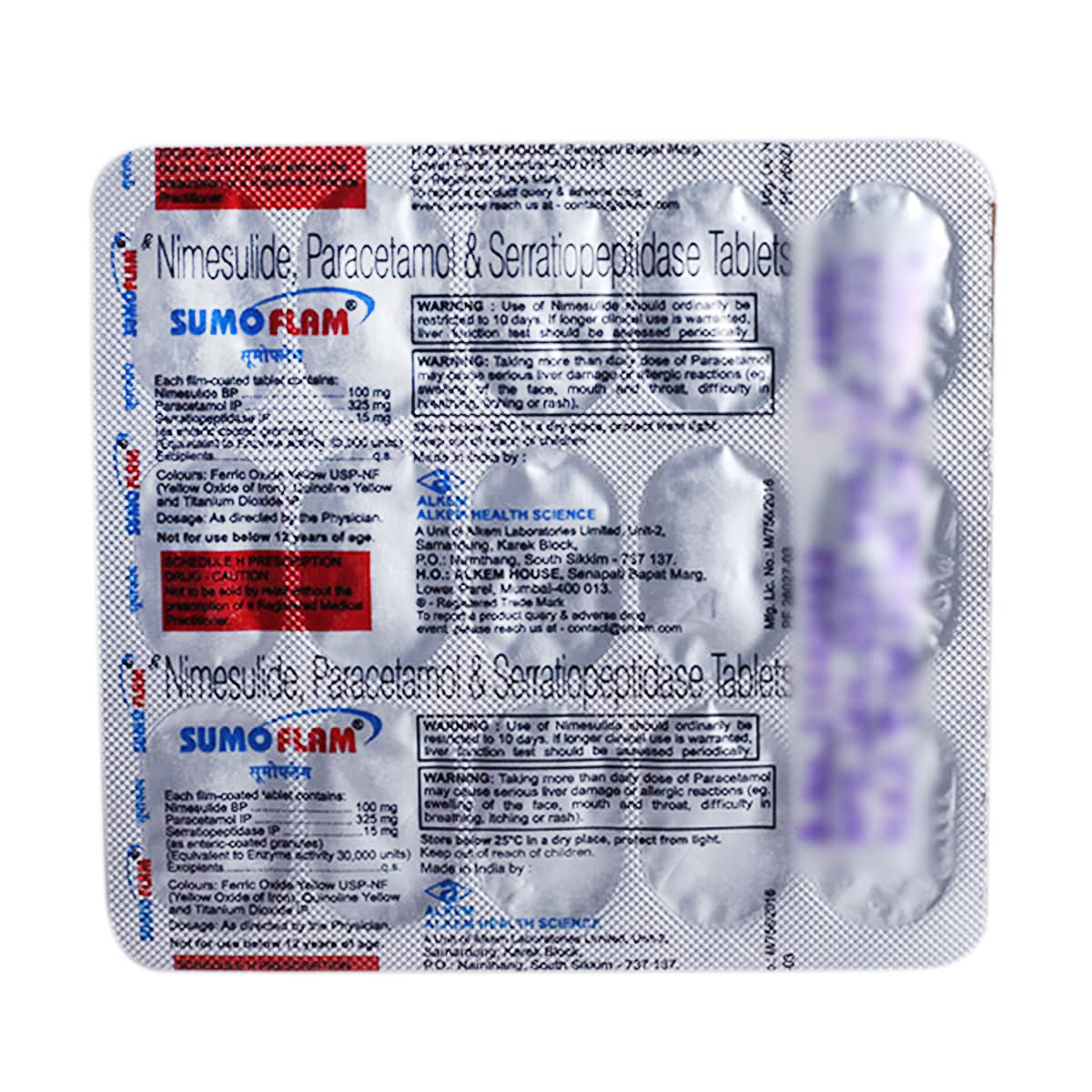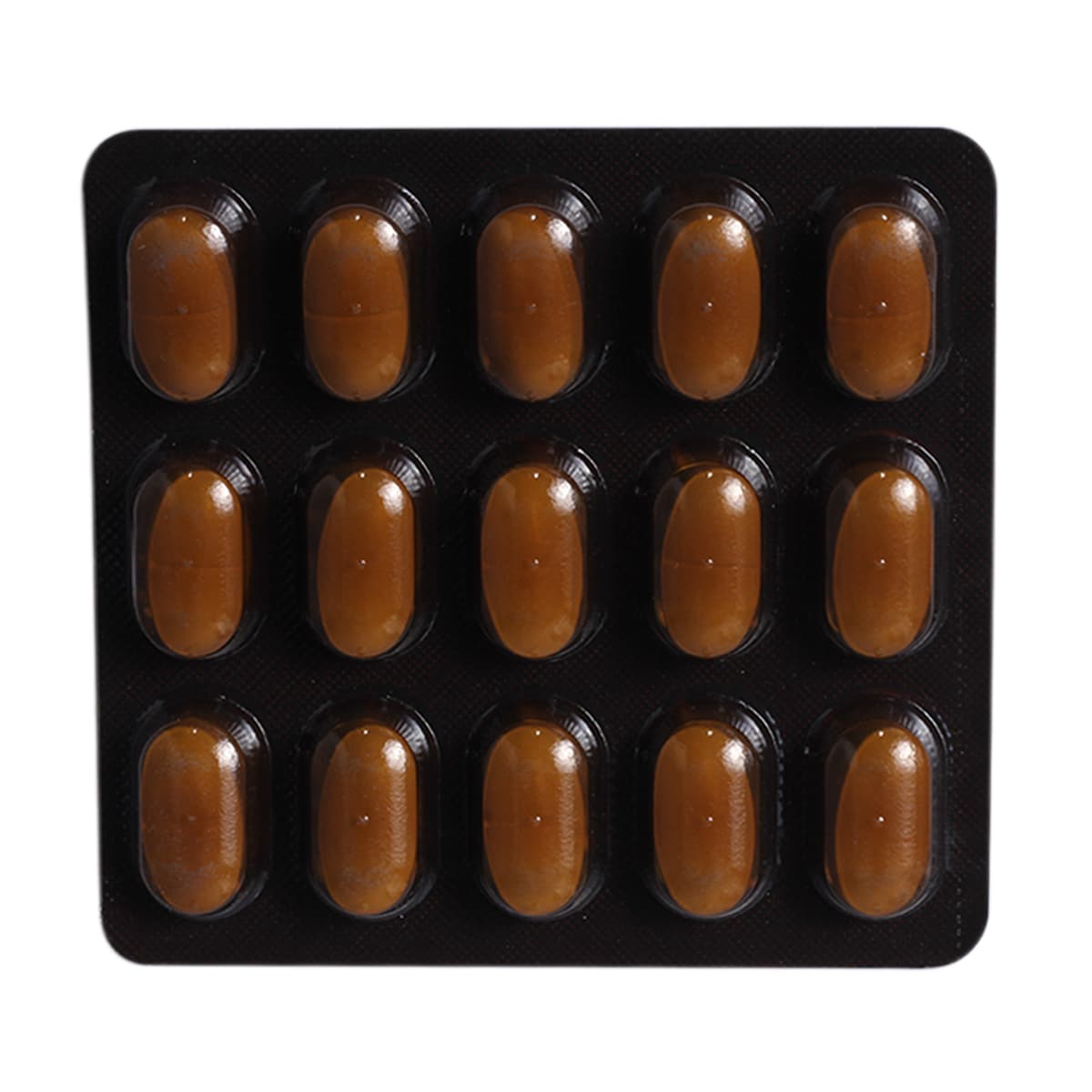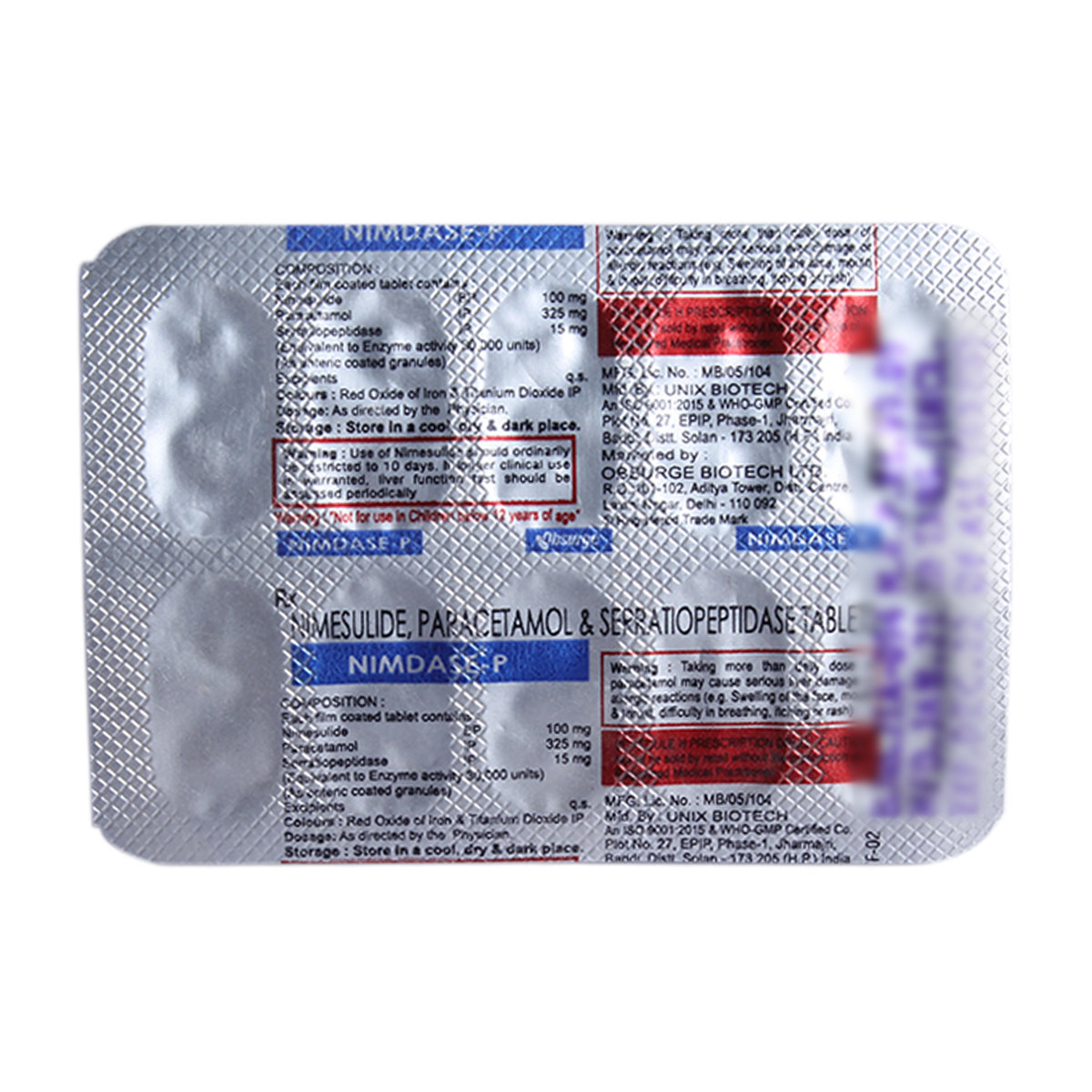Sumoflam Tablet


MRP ₹208.5
(Inclusive of all Taxes)
₹31.3 Cashback (15%)
know your delivery time
Provide Delivery Location
Manufacturer/Marketer :
Consume Type :
Expires on or after :
Return Policy :
Selected Pack Size:15
15 ₹187.7
(₹12.51 per unit)
In Stock
10 ₹125.1
(₹12.51 per unit)
In Stock

Secure Payment

Trusted by 8 Crore Indians

Genuine Products
Therapeutic Class
Country of origin
Manufacturer/Marketer address
Disclaimer
Alcohol
Safe if prescribed
Consumption of alcohol may increase the risk of liver damage and serious side effects.
Pregnancy
Consult your doctor
Sumoflam Tablet is not recommended for use in pregnancy. Please consult your doctor if you are pregnant before taking this medicine.
Breast Feeding
Consult your doctor
Sumoflam Tablet should not be used in breastfeeding mothers as it may pass into breastmilk and cause unwanted effects to the nursing baby. However, if prescribed, the doctor may advise you to stop breastfeeding.
Driving
Safe if prescribed
Sumoflam Tablet may not affect your ability to drive. However, do not drive or operate heavy machinery if you feel dizzy.
Liver
Consult your doctor
Sumoflam Tablet should not be used if you have severe liver disease, as this medicine may worsen your condition.
Kidney
Consult your doctor
Sumoflam Tablet should be used with caution if you have kidney problems. your doctor may adjust the dose or prescribe a suitable alternative based on your condition.
Children
Safe if prescribed
Sumoflam Tablet is not recommended for use in children below 12 years of age.
Product Substitutes
About Sumoflam Tablet
Sumoflam Tablet belongs to the class of medications called ‘analgesics’ used to treat mild to moderate pain. It can relieve pain, swelling, and inflammation associated with various chronic (long-term) conditions, such as rheumatoid arthritis (joint pain, especially in the hands and feet) and osteoarthritis (joint pain, especially in the knees, hip, hands, neck, and lower back). It can also relieve acute (short-term) pain such as toothache, ear pain, throat pain, muscle ache, and backache.
Sumoflam Tablet is a combination medicine that contains Nimesulide, Paracetamol, and Serratiopeptidase. Nimesulide and Paracetamol are pain killers. They can also reduce fever and inflammation. They act by blocking the action of chemical messengers responsible for pain, fever, and inflammation. On the other hand, Serratiopeptidase is an enzyme which works by breaking down abnormal proteins at the site of inflammation and promotes healing.
Sumoflam Tablet is available in the form of a tablet. It would be best if you took this Sumoflam Tablet precisely as prescribed by your doctor. Sumoflam Tablet may cause side effects such as nausea, vomiting, indigestion, stomach pain, headache, heartburn, and diarrhoea. These side effects are usually mild and temporary. However, if any of these side effects persist or worsen, consult a doctor immediately.
Do not take Sumoflam Tablet if you are allergic to any of its contents. Sumoflam Tablet should not be used in patients with liver failure, severe kidney failure, heart failure, gastric ulcers, bleeding disorders, and alcohol or drug abuse. Before taking Sumoflam Tablet , inform your doctor if you are pregnant or breastfeeding. Sumoflam Tablet should not be given to children below 12 years of age. In elderly people, Sumoflam Tablet may be given with caution. Alcohol should not be taken while using Sumoflam Tablet as it further increases the risk of liver damage. Sumoflam Tablet may not affect your ability to drive. However, do not drive or operate heavy machinery if you feel dizzy.
Uses of Sumoflam Tablet
Medicinal Benefits Mweb
Key Benefits
Sumoflam Tablet is a combination medicine that contains Nimesulide, Paracetamol, and Serratiopeptidase. Nimesulide is a non-steroidal anti-inflammatory drug (NSAID). Paracetamol is an analgesic and antipyretic. Both medicines can reduce pain and fever. They act by blocking the action of chemical messengers responsible for pain, fever, and inflammation. Serratiopeptidase is an enzyme. It causes thinning of the fluids around the damaged tissue, thereby making fluid drainage easier in the swollen tissue. This effect reduces swelling and promotes faster healing. Together, Sumoflam Tablet can effectively reduce pain, swelling, and inflammation.
Directions for Use
Side Effects of Sumoflam Tablet
- Nausea
- Vomiting
- Indigestion
- Stomach pain
- Headache
- Heartburn
- Diarrhoea
Drug Warnings
Sumoflam Tablet may cause liver damage on higher doses or when used for prolonged periods. So, if you notice signs of liver damage such as loss of appetite, nausea, vomiting, unexplained weight loss, dark urine, and fatigue, or if you have abnormal liver function tests, discontinue the treatment immediately and consult your doctor. Do not use other analgesics while using Sumoflam Tablet . Sumoflam Tablet may have affected fertility, so it is not recommended for women trying to conceive. Sumoflam Tablet may interfere with blood clotting, so it is recommended to stop using this medicine at least 2 weeks before surgery.
Drug-Drug Interactions
Drug-Drug Interactions
Login/Sign Up
Co-administration of Sumoflam Tablet may decrease the excretion rate of Oxazepam which could result in a higher serum level.
How to manage the interaction:
Although there is a possible interaction between Oxazepam and Sumoflam Tablet, you can take these medicines together if prescribed by a doctor. Do not stop using any medications without a doctor's advice.
Co-administration of ketamine and Sumoflam Tablet may decrease the effectiveness of Ketamine which could result in a higher blood level.
How to manage the interaction:
Although taking Ketamine and Sumoflam Tablet together can evidently cause an interaction, it can be taken if a doctor has suggested it. If you're feeling very sleepy or having trouble breathing, it's important to contact your doctor right away. Do not stop using any medications without a doctor's advice.
Co-administration of Teriflunomide with Sumoflam Tablet may increase the risk or severity of Liver problems.
How to manage the interaction:
Taking Sumoflam Tablet with Teriflunomide together can possibly result in an interaction, but it can be taken if a doctor has advised it. Do not discontinue any medications without consulting a doctor.
Co-administration of Sumoflam Tablet and Ketoconazole may increase the risk of liver injury.
How to manage the interaction:
Although there is a possible interaction between Sumoflam Tablet and Ketoconazole, you can take these medicines together if prescribed by a doctor. However, if you have joint pain or swelling, fever, chills, unusual bleeding or bruising, skin rash, itching, over-tiredness, nausea, vomiting, loss of appetite, stomach pain, dark-colored urine, light-colored stools, and/or yellowing of the skin or eyes, contact a doctor immediately as these may be signs and symptoms of liver damage. Do not discontinue the medication without consulting a doctor.
Co-administration of Sumoflam Tablet and Leflunomide may increase the risk of liver problems.
How to manage the interaction:
Although there is a possible interaction between Sumoflam Tablet and Leflunomide, they can be taken together if prescribed by a doctor. However, if you experience fever, chills, joint pain or swelling, unusual bleeding or bruising, skin rash, itching, less desire to eat, fatigue, nausea, vomiting, abdominal pain, or yellowing of the skin or eyes, contact a doctor immediately. Do not discontinue any medications without consulting a doctor.
Co-administration of Sumoflam Tablet and Valdecoxib may increase the risk or severity of adverse effects.
How to manage the interaction:
Although there is a possible interaction between Sumoflam Tablet and Valdecoxib, you can take these medicines together if prescribed by a doctor. However, if the side effects worsen, please consult a doctor.
Co-administration of Lomitapide and Sumoflam Tablet may increase the risk of severity of liver injury.
How to manage the interaction:
Although there is a possible interaction between Sumoflam Tablet and Lomitapide, you can take these medicines together if prescribed by a doctor. Do not stop using any medications without a doctor's advice.
Co-administration of Mipomersen with Sumoflam Tablet may increase the risk or severity of liver injury.
How to manage the interaction:
There may be a possibility of interaction between Sumoflam Tablet and Mipomersen, but it can be taken if prescribed by a doctor. Do not stop using any medications without talking to a doctor.
Drug-Food Interactions
Drug-Food Interactions
Login/Sign Up
Drug-Diseases Interactions
Drug-Diseases Interactions
Login/Sign Up
Drug-Drug Interactions Checker List
- IBUPROFEN
- DICLOFENAC
- NAPROXEN
- WARFARIN
- CLOPIDOGREL
- METOCLOPRAMIDE
- DOMPERIDONE
- LITHIUM
- METHOTREXATE
- CYCLOSPORINE
- CHOLESTYRAMINE
Habit Forming
Diet & Lifestyle Advise
-
Include more glucosamine, chondroitin sulphate, Vitamin D, and calcium-enriched supplements. Besides this, turmeric and fish oils can help reduce inflammation in the tissue.
-
Please do not go for heavy exercise as it may increase your joint pain in arthritis. Instead, you can do stretching and low-impact aerobic exercises like walking on a treadmill, bike riding, and swimming. You can also strengthen your muscle strength by lifting light weights.
-
In the chronic conditions of arthritis or joint pain, fish like salmon, trout, tuna, and sardines. These fishes are enriched with omega-3 fatty acids with a minimum level of chemicals called cytokines, which ramp up inflammation.
-
Your sitting posture is important, especially when have pain and inflammation condition. Try to sit as little as possible and only for a short time (10-15 min). Use back support like a rolled-up towel at the back of your curve to minimize pain. Keep your knees and hips at a right angle. Besides this, you can use a footrest if required.
All Substitutes & Brand Comparisons
RX
Out of StockAbhinim Plus 100mg/325mg/15mg Tablet
Sb Life Sciences
₹49
(₹4.41 per unit)
64% CHEAPERRX
Out of StockEfnim SP 100mg/325mg/15mg Tablet
₹50
(₹4.5 per unit)
64% CHEAPERRX
Out of StockCrednim SP 100mg/325mg/15mg Tablet
₹56
(₹5.04 per unit)
59% CHEAPER

Have a query?
Buy best C.n.s Drugs products by
Intas Pharmaceuticals Ltd
Sun Pharmaceutical Industries Ltd
Torrent Pharmaceuticals Ltd
Alkem Laboratories Ltd
Abbott India Ltd
Cipla Ltd
Alteus Biogenics Pvt Ltd
Micro Labs Ltd
Lupin Ltd
Ipca Laboratories Ltd
D D Pharmaceuticals Pvt Ltd
Icon Life Sciences
Mankind Pharma Pvt Ltd
Tripada Healthcare Pvt Ltd
Arinna Lifesciences Ltd
Linux Laboratories Pvt Ltd
East West Pharma India Pvt Ltd
La Renon Healthcare Pvt Ltd
Talent India Pvt Ltd
Tas Med India Pvt Ltd
Zydus Healthcare Ltd
Cnx Health Care Pvt Ltd
Eris Life Sciences Ltd
Leeford Healthcare Ltd
Emcure Pharmaceuticals Ltd
Macleods Pharmaceuticals Ltd
Sigmund Promedica
Aristo Pharmaceuticals Pvt Ltd
Dr Reddy's Laboratories Ltd
Troikaa Pharmaceuticals Ltd
Consern Pharma Ltd
Zydus Cadila
Shine Pharmaceuticals Ltd
Wockhardt Ltd
Ardent Life Sciences Pvt Ltd
Crescent Formulations Pvt Ltd
Theo Pharma Pvt Ltd
Reliance Formulation Pvt Ltd
Ikon Pharmaceuticals Pvt Ltd
Propel Healthcare
Neon Laboratories Ltd
Jagsam Pharma
Msn Laboratories Pvt Ltd
Morepen Laboratories Ltd
Pulse Pharmaceuticals
Sanofi India Ltd
Med Manor Organics Pvt Ltd
Hetero Healthcare Pvt Ltd
Novartis India Ltd
Crescent Therapeutics Ltd
Elder Pharmaceuticals Ltd
Solvate Laboratories Pvt Ltd
Akumentis Healthcare Ltd
Mova Pharmaceutical Pvt Ltd
Psyco Remedies Ltd
Tripada Lifecare Pvt Ltd
Ajanta Pharma Ltd
Cyrus Remedies Pvt Ltd
Medishri Healthcare Pvt Ltd
Cadila Healthcare Ltd
Glenmark Pharmaceuticals Ltd
Matteo Health Care Pvt Ltd
Hbc Life Sciences Pvt Ltd
Lyf Healthcare
Matias Healthcare Pvt Ltd
Mesmer Pharmaceuticals
Alembic Pharmaceuticals Ltd
Capital Pharma
Crescent Pharmaceuticals
Medopharm Pvt Ltd
Alniche Life Sciences Pvt Ltd
Kivi Labs Ltd
Talin Remedies Pvt Ltd
USV Pvt Ltd
Quince Lifesciences Pvt Ltd
Solis Pharmaceuticals
Infivis Life Care
Zuventus Healthcare Ltd
Cadila Pharmaceuticals Ltd
Pfizer Ltd
Wallace Pharmaceuticals Pvt Ltd
A N Pharmacia Laboratories Pvt Ltd
Blue Cross Laboratories Pvt Ltd
Jenburkt Pharmaceuticals Ltd
Lia Life Sciences Pvt Ltd
Mano Pharma
Medley Pharmaceuticals Ltd
Primus Remedies Pvt Ltd
FDC Ltd
Maneesh Pharmaceuticals Ltd
Apex Laboratories Pvt Ltd
Gagnant Healthcare Pvt Ltd
Ozone Pharmaceuticals Ltd
RPG Life Sciences Ltd
Strides Shasun Ltd
Unichem International
GlaxoSmithKline Pharmaceuticals Ltd
Kuresys Labs Pvt Ltd
LA Pharma
Trion Pharma India Llp




